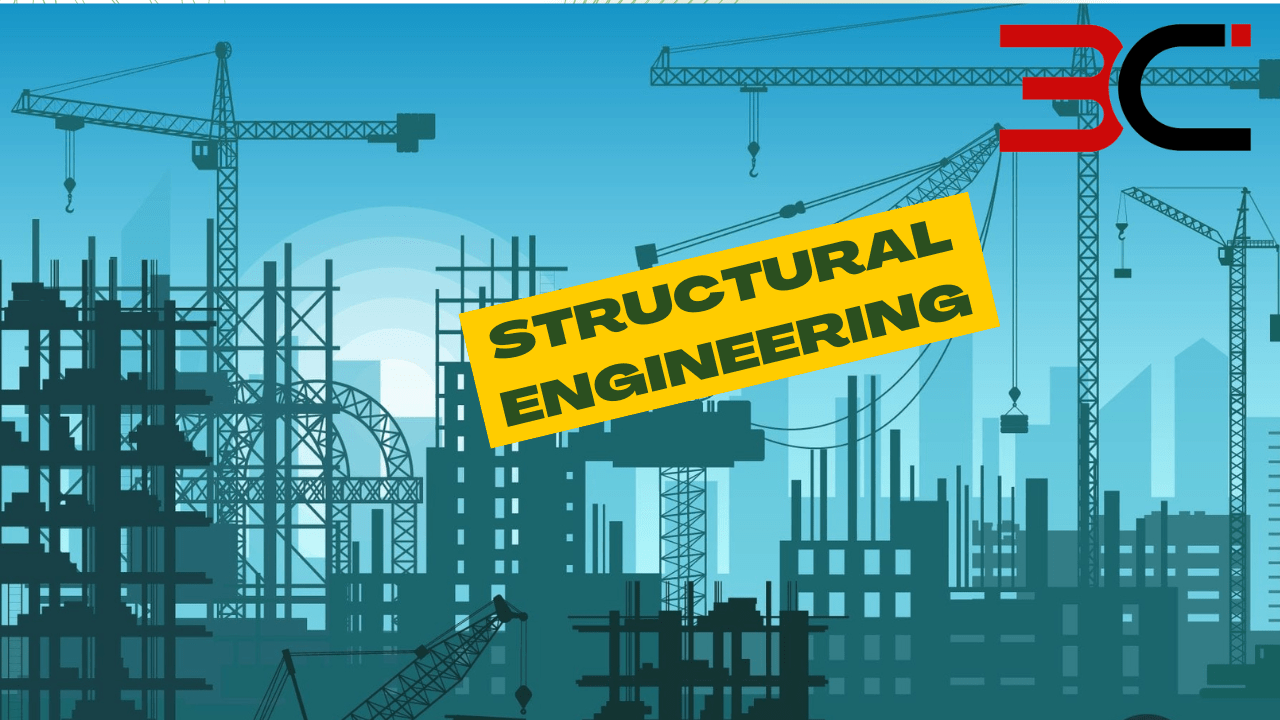Structural engineering is the process of designing, modifying, and testing a system to allow it to meet the needs of users.
The actual accomplishments that serve as a foundation for a newcomer’s profession in structural analysis are firmly rooted in structural design basics. They are the structural engineer’s teachings of security and stability, and all practicing engineers are likely to apply them at specific times.
In this article, we will talk about structural engineering and its details. So let’s go and start the article.
What is Structural Engineering?
Structural engineering is the designing and building structures to bear loads and strains to minimize or maximize survivability.
Structures can be in commerce or in the research and development stages, where they are test-driven to optimize survivability under various conditions.
Structural engineers use traditional design methods, Computer-Aided Design (CAD), scientific software packages such as Finite Element Analysis (FEA) or laminar stress-based design (ASBD), interface foundation theories, methods, and physics.
- The Millau Viaduct: Located in Millau, France, it is the tallest cable-stayed road bridge in the world.
- The Venice Tide Barrier Project: The Venice Tide Barrier Project is the world’s largest flood prevention project in Venice, Italy.
- The National Stadium: National Stadium, a.k.a. Bird’s Nest is located in Beijing, China.
The Basics of Structural Engineering
Structural engineering studies how physical, chemical and electrical forces interact to create structures.
- It’s an area of engineering that involves the construction of buildings, bridges, tunnels, dams, and other large-scale infrastructure projects. It is one of the structural engineering basics.
- Structural engineers typically work with engineers who specialize in other fields – such as civil engineering or materials science – to help them understand the principles behind these structures.
- Structural engineering is an essential field of engineering. It has been used for centuries but has become more complex as technology advances with the use of structural engineering software.
- Applying structural engineering involves dealing with forces and moments acting on physical structures.
- These forces can be mechanical or thermal, such as bending moments or shear forces, or they can be gravitational forces in the form of acceleration.
The Types for the Structural Design of a Building:
Along with knowing the guidelines for the structural design of a building, we should also talk about the types. Here are the most renowned structural designs –
- Slab Design
- Slab Beam Design
- Lintel Beam Design
- Column Design
- Plinth Beam Design
- Footing Design
Slab Design
A slab design is a type of structural building design. Slabs are long, thin pieces of metal or plastic that are placed along the side of a building to create stable and efficient structural systems.
The advantages of using slabs for building construction include their low cost, easy installation, and efficient use of resources.
The main disadvantage to using slabs is their short life span, which can be affected by many factors, such as weather conditions and vandalism.
Slab Beam Design
Slab beam design is a good choice for a structural building design. It is a popular design because it can be used to create solid and durable structures. The slab beam design is easy to use and has many advantages over other methods.
Lintel Beam Design
Lintel Beam Design is a building structural design software that helps to create a strong and efficient frame for a building.
The software provides users with an easy-to-use interface, allowing them to plan, create, and analyze structural loads. Lintel Beam Design has many advantages over other structural design software. Here they are:
- First, it is designed specifically for the needs of building designers, making it the perfect tool for achieving accurate results.
- Second, its intuitive user interface makes it easy to understand what you are doing.
- Third, Lintel Beam Design has many features that make it unique compared to other structural design programs.
- These include support for both traditional framing systems and progressive beam design.
- Fourth, its sophisticated analysis tools allow you to understand and analyze the structural performance of your buildings in ways never possible with other programs.
Column Design
Columns are a standard part of structural design. They are essential for stability and support in buildings. Columns can be designed in various ways, including simple ones without any advanced features, or with features that make them more complex.
The advantage of designing columns with advanced features is that they create a more stable and secure building. Columns can also be combined with other components, such as walls and floors, to create a complete design.
Plinth Beam Design
A plinth beam is a structural beam that supports a building’s design. A plinth beam generally includes a long-tempered shaft and two straight sticks. The longitudinal member is attached to the superstructure using screws or nails, while the lateral members are connected to the superstructure using bolts.
The plinth beam can be used in either a through-thickness or cross-thickness design. The through-thickness design allows for more efficient use of space, while the cross-thickness design provides better strength and stability.
Footing Design
Footing Design is a system that uses foundation walls and footing systems to create a stable foundation for a building. This system can help to reduce the risk of debris and wind causing damage to the building.
One advantage of footing design is that it can be used to design structural building designs. Another advantage of footing design is that it can be used in conjunction with other design methods, such as nominally framed construction.
By using Footing Design, the customer can have a more accurate and comprehensive understanding of the built environment and thus be able to make better decisions about construction.
Some Promising Structural Engineering Careers
Structural engineering jobs offer a variety of opportunities for advancement and learning. The latest structural technologies are used in various products, making it an exciting career to pursue. Some promising structural engineering careers and details are given below:
# Civil Design Technician (Salary: estimating $75,000 per year)
| Job Responsibilities: | Benefits: | Eligibilities: |
| To complete a project, a technician should work closely with other technicians, designers, and engineers. Drawings and overlays can be prepared using AutoCAD software. Provide assistance to engineers and designers by measuring existing plans and preparing drawings based on those measurements. | Flexible schedule, generous PTO, and assistance.Health, dental, vision, and life insurance. | A Bachelor’s degree from any reputed university. |
# Civil Engineer (Salary: estimating $1,10,000 per year)
| Job Responsibilities: | Benefits: | Eligibilities: |
| Processes and requirements for developing client procedures and systems.Software for design. Various disciplines are coordinated, including transportation and traffic. Assist in the preparation of permit applications for various municipalities. | Feasible schedule, generous assistance, and PTO.Reimbursement of tuition costs. Employees are eligible for health, dental, vision, and life insurance. | A minimum of a Bachelor’s degree from any reputed university.Practical experience of using tools and software |
# Project Engineer (Salary: estimating $80,000 per year)
| Job Responsibilities: | Benefits: | Eligibilities: |
| Establishing client-specific procedures and system requirements. There are several design software packages available. Coordinating the activities of municipalities, transportation agencies, traffic authorities, and other organizations. Apply for a variety of municipal permits. There are two types of pavement designs: flexible pavements and rigid pavements. pavements. | Flexible working hours and great work placement. Insurance is available. | A university Bachelor’s degree.A professional engineer’s license.Four to six years of experience. |
Okay! Now let’s take a look at the general factors of a career in structural engineering or civil engineering –
- With the right skills and experience, structural engineers can help make products safer, more efficient, and more affordable.
- Some of the most common structural engineering jobs include piping and metalwork specialist, civil engineering technician, plant engineer, and project engineer.
- The benefits of a structural engineering career include excellent pay and working with some of the most innovative companies in the industry.
- Structural engineers can use their knowledge and experience to improve products and services worldwide.
- In addition, they have the opportunity to work with clients from all over the world, giving them an unmatched global perspective.
FAQ
- What are the structural engineering courses that offer certificates?
Ans: Structural engineering is a branch of engineering that deals with the design and construction of infrastructure, including bridges, tunnels, dams, and other structures.
These courses offer certificates that can be used to understand how these types of structures are built.
Structural engineers are responsible for designing and implementing systems that maintain or improve the integrity of buildings and infrastructure.
- What are the common structural engineering interview questions?
Ans: The most frequently asked questions for an interview include the following:
- What are the most commonly associated with buildings?
- How do they investigate potential failure points in a building?
- What are the most effective ways to reduce the incidence of damage to infrastructure?
- What is the essential structural engineering software?
Ans: Structural engineering software includes tools that allow engineers to design and analyze structures and optimize them for safety and performance. Some structural engineering software is:
- PEMDAS – It is a mathematical software that is used for doing mnemonic acronyms. They calculate several operations in single expressions.
- ABAQUS – Used for FEM structural engineering.
- ArchiCAD is a BIM and 3D modeling software used in structural engineering.
- STAAD – It is also a 3D modeling and BIM software.
- OpenSees – This tool is used for earthquake engineering.
- ETABS – Used for FEM structural engineering.
Also, FEAM, ARCAM, and AFDC are good software for structural engineering.
These software tools can be used in various settings, including civil engineering, mechanical engineering, and earth science.
Final Words
So we claim structural engineering is an excellent subject to study and a necessary procedure for engineering. A person needs to learn some basic things about this for life, and significantly more dedication is required for better quality studies. here we offers some civil engineering courses according to your needs. you can enroll our civil courses to became a expert engineer.
We hope our readers will be helped by this article, which will guide them in their future structural engineering projects.

